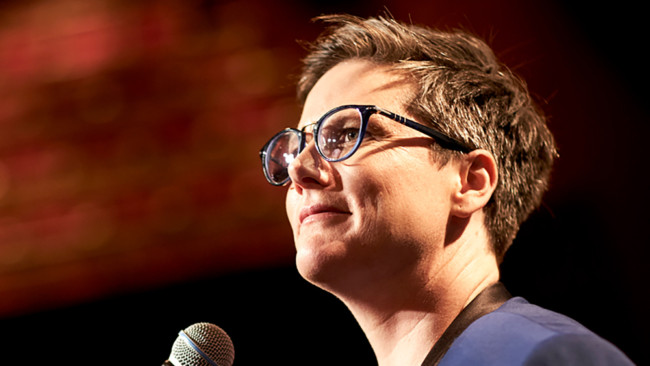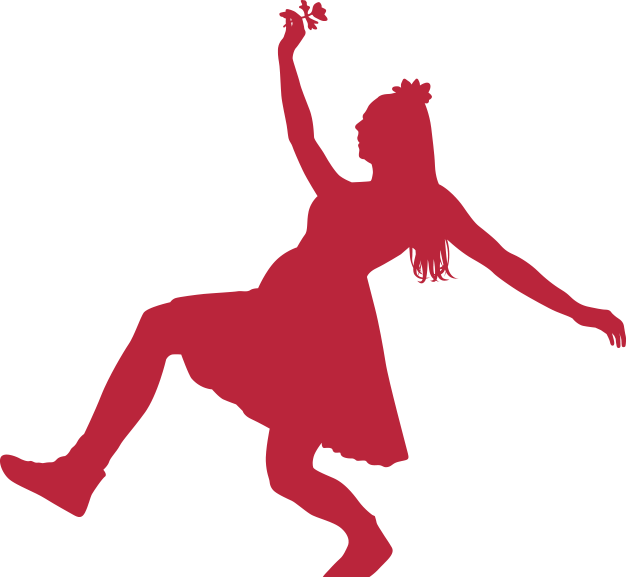The Fine Line between Comedy and Trauma
Jul 10 2018

Have you seen Hannah Gadsby's 'Nanette' on Netflix yet? If you haven't, what are you waiting for? Cancel your plans and set up your telly-box right now! If you haven't got Netflix, get it or hassle a friend who has. I know, it's hot and you've got things to do, but this is one of the bravest, most powerful comedy shows you'll see. Take it from me, I've seen a few!
At the top of her hour-long live show, Hannah Gadsby boldly announces that after over a decade of live shows, she thinks it's time she quit comedy. Her explanation of why, is intricately woven in between carefully placed material about growing up in Tasmania, coming out, the history of art, feminism, not fitting in with the flamboyant homosexuals, after-show feedback she's received from well-meaning lesbians and opinions she's received from “helpful” men, via an eloquently explained lesson on tension in comedy;
“When you laugh, you release tension and when you hold tension in your human body, it's not healthy...psychologically or physically. It's even better to laugh in a room full of people... because laughter is infectious... so you stand to release more tension when you laugh with other people than you would if you laugh alone...”
Laughter as medicine is a well-researched area and one that I've spent large amounts of time wading through. During my dissertation year, I read umpteen studies on the benefits of laughter; studies so dry, I imagined the lab-coated scientists who'd written them, earnestly trying to measure laughter in test tubes wearing protective gloves and goggles. Hannah delicately dissects laughter even further, explaining how jokes work:
“A joke is simply two things, a set up and a punch line. It is essentially a question with a surprise answer. But in this situation, it's a question that I have artificially inseminated with tension, I do that, that's my job, I make you tense and then I make you laugh...”
She is a self-confessed master of tension, as all the best comedians are. Comedians take their place up on the stage, raise their batons and conduct their audience like a an orchestra, provoking wave after wave of laughter through squeezing and releasing the air in the room, building up expectation and anticipation and then breaking it, “ha ha,” and adding a little surprise twist “Ha ha ha,” oh the blessed relief!
Again, tension in comedy is widely written about. But what isn't so widely proliferated, is Gadsby's lived experience of the negative effects of internalising tension, a little-known comic's job-hazard:
“Stories, unlike jokes, need three parts, a beginning, a middle and an end. Jokes only need two parts, a beginning and a middle.”
Hannah explains that in converting her past trauma into jokes, she has inadvertently caused herself more trauma. As explained earlier, jokes are built on tension and release, which leaves no space for exposition, subtlety or the complicated grey area which makes up most of life. Through repeatedly telling the joke version of her life, using just the beginning and middle of her experiences, Hannah's jokes have become enmeshed with reality, until she's found herself frozen in time, unable to move on from incredibly traumatic experiences.
“Punchlines need trauma, because punchlines need tension and tension feeds trauma.”
This has got me thinking about my devising process. When I direct devised autobiographical comic performance, I offer space and holding to process past trauma, before considering what might be presented for audiences, it's a lengthy process which wends it's way through storytelling, emotional expression, movement, meditation, writing and focussing. Most of the material produced will never be seen by an audience, but without the process, the performer will be operating largely from an unconscious place, which leaves them less in control of their material; how they tell it and what impact they would like to have on audiences.
When operating from an unconscious place, performers can inadvertently cast the audience as the perpetrator, or as their therapist, or as a parent, which makes for a very strange viewing experience.
I've experienced this myself as a performer, and I've seen it in the performers I direct; when we're swamped with trauma, there is no space between us and our material. When left in the unconscious, trauma calls the shots and what trauma wants is more trauma. The intricate process of untangling and teasing out the material from the trauma, offers the performer perspective which is vital for comedy. Without perspective there is no room for play.
Since training as a dramatherapist and going through a lot of trauma therapy myself, I've felt strongly that putting unprocessed trauma on stage is not only potentially triggering for the performer, but can also trigger the audience and should be avoided at all costs. But listening to Hannah, I hear the high cost she's paid to keep her trauma off the stage. I feel really sad that her experience of comedy has closed her processing down.
My experience is the opposite. I have found as a performer (and a human), the more I am able to speak my truth, my whole truth, without the need for gags, the funnier I become. In my experience, tension and release are not the sole sources of laughter! There is a niche I've been carving that sees recognition of the human condition as the biggest source of laughter. In the style of comedy I've been performing and teaching to others, there is space for subtlety and vulnerability. I've found time and time again, when we embrace our vulnerability and offer it to audiences, not as weakness, but as power, the effect it has is electric.
In Nanette, I saw Hannah do just that. She stood in her vulnerability and connected to the audience straight from her heart. Was it comedy though? Yes, for me it was comedy, exactly how comedy should be: an invitation towards connection, a conduit to something way deeper than laughter merely caused by tension and release.
Hannah's experience and skill as an intelligent comedian allowed her to carefully lead the audience step by step, deeper and deeper into her own private world; she enticed us down each step with a carefully placed laugh, until we reached the very bottom. That's when Hannah made the bold choice to put the baton down and stop conducting the laughter. At this point, she brazenly told her story, all the ugly, confusing, murky parts of it she'd previously omitted, in favour of getting the laughs. Her story gushed out of her in a flurry of well-written and well-owned pain, anger and sadness. She did not break the tension:
“This tension, it is yours, I am not helping you anymore. You need to learn what this feels like because this, this tension is what “not normals” carry inside them ALL of the time because it is DANGEROUS TO BE DIFFERENT.”
As I watched, the tears poured down my face. She nailed it. Using the medium of comedy, a medium that's often associated with entertainment, escapism and frivolity, using the tension she'd created, Hannah let us feel how she felt. I cried for her, I cried for me, I cried for everyone who's let me into their private worlds. It's not easy to be different, to walk your own path, to be a “not normal,” but my unique position, as a clown teacher and comedy facilitator, lets me know that there are loads of us and through connecting with others, we're gaining in confidence to put ourselves out there and be seen.
How we tell our story is essential for our personal growth. Tell it well and we'll find healing. Tell it well and we'll find others who are walking the same path.
As storytellers, we have a responsibility towards taking care of how the seeds of our stories land in our listeners. We can't take full responsibility for what they'll grow into, but we can do the processing needed to own our stories and diffuse the trauma off stage, so that we can offer our stories to audiences with open hands and open hearts, so that they can feel connected to their own stories and maybe even emboldened to tell them.
I salute you Hannah Gadsby.



